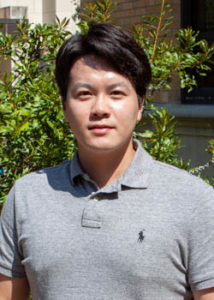Uranium enrichment has gained a lot of attention in recent years because of the possibility for diverting material from peaceful uses and of enriching uranium beyond acceptable limits. One of the safeguards challenges for uranium enrichment lies in accounting for material and preventing diversions through the enrichment process.

In uranium enrichment, UF6 gas is fed to into the cascades of centrifuges. During the enrichment process, material can be deposited as a solid in the internals of the pipes. This deposited material is known as holdup. Holdup poses many challenges to safeguards and the accurate accounting of material. Yeongchan Kim, a graduate student with the Center for Nuclear Security Science and Policy Initiatives (NSSPI), worked with NSSPI Director Dr. Sunil Chirayath to investigate how uranium holdup, if not properly handled, can affect the accurate accounting of uranium material and hence the nuclear material safeguards.
According to Kim, “holdup measurements are difficult and challenging. Therefore, understanding the effect of holdup uranium accounting in uranium enrichment plants is very important, and that is what my M.S. study investigated.”
Kim used the Monte Carlo Transport code (MCNP) to model a simple centrifuge pipe with a sodium iodide detector to analyze gamma radiation count rates. Kim’s research showed that holdup of uranium in the internals of the centrifuge pipe can indeed affect the uranium material accounting.
“In the simulations,” said Kim, “holdup had 0.72 at% U-235 (natural uranium) concentration, so it gave low gamma radiation count rates. This concealed LEU [low enriched uranium] for more than 5% production. Considering other factors, this proves that 7% UF6 can be produced for 60g/m of holdup in the pipe used in the model.”
Undetected diversion is one safeguards problem related to holdup in gas centrifuge enrichment facilities; however, false alarms may also be caused by holdup and lead to unnecessary inspections. Kim studied false alarms due to holdup to determine where thresholds should be established for detection. All of these analyses point to more work to be done to account for holdup to assure that it does not adversely affect uranium material accounting.
“This project helped me learn to apply the theories that I’ve learned from classes for the real world,” remarked Kim.
Having successfully defended his thesis in June, Kim will be graduating this summer with a Master’s of Science in Nuclear Engineering with a specialization in nuclear nonproliferation. Kim is a Captain in the Republic of Korea Army, and his previous assignment was as the 1st platoon leader of the engineer combat battalion of the 3rd infantry division. After graduation from Texas A&M University, he will serve as a radiologist in the South Korean CBRPC (Chemical, Biological, and Radiological Protection Command). He received his Bachelor’s degree in civil engineering from the Korean Military Academy in 2015.